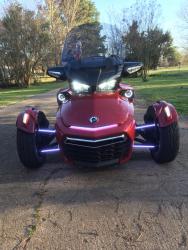|
-
Active Member

 Do I need to change the Oil again so soon? Do I need to change the Oil again so soon?
I got a 2014 RTS and had the oil changed last year April 2018 and had 25,136 miles on the Spyder. This was my 28,000 mileage checkup. My question is, now I have a little over 30,000, miles and am wondering, if I need to have my oil changed. With only a little over 4,000 miles and Spyder sat over the winter, do I or should I have the oil changed? Thanks in advance for your suggestions.
2011 RT-S SE5 Viper Red
2014 RT-S SE6 Cognac
Bajaron sway bar w/ aluminum heims
Custom Design HM Brake light
Custom Design Red front fender lights with turn signals
Lidlox
Corbin arm rests
-

I would not.
Owners' manuals go by miles not time. In my Spyder manual it states to change at 3000 miles. No comment about time.
Now, personally, I'd change it annually. But WHEN during the year is based (for me) on miles at October 1. If it's close I change it and ride a little. If it's not close I ride it for a while the next year, and try to change around the same month as last change. I have forgotten to do this on one ride, and it was 2.5 years between changes. No harm done.
-
Very Active Member


 Originally Posted by viperryder

I got a 2014 RTS and had the oil changed last year April 2018 and had 25,136 miles on the Spyder. This was my 28,000 mileage checkup. My question is, now I have a little over 30,000, miles and am wondering, if I need to have my oil changed. With only a little over 4,000 miles and Spyder sat over the winter, do I or should I have the oil changed? Thanks in advance for your suggestions.
See my comment about this very issue. https://www.spyderlovers.com/forums/...-OK-check-mark!

2014 Copper RTS
Tri-Axis bars, CB, BajaRon sway bar & shock adjusters, SpyderPop's Bumpskid, NBV peg brackets, LED headlights and modulator, Wolo trumpet air horns, trailer hitch, custom trailer harness, high mount turn signals, Custom Dynamics brake light, LED turn signal lights on mirrors, LED strip light for a dash light, garage door opener, LED lights in frunk, trunk, and saddlebags, RAM mounts and cradles for tablet (for GPS) and phone (for music), and Smooth Spyder belt tensioner.
-
Very Active Member


Yes you should. The owners manual states every 9300 miles OR one year whichever comes first. Once an engine has been run on new oil the contamination and formation of acids in the oil starts. It continues (although slower) even if the engine is not run. There is a time component to oil life in an engine that runs once in a while.
-
Very Active Member


Yes oil does break down over time so it is always a good thing to change your oil once a year or every 9300 miles whatever comes first.

2017 F3 Limited in Intense Red Pearl
2008 Triumph Rocket (SOLD)
2002 Honda VTX 1800 C ( SOLD)
2014 Triumph Thunderbird Commander
-
SpyderLovers Sponsor


9,300 miles or once a year is more of a good recommendation for the 1330 than a hard and fast rule. Though if you violate it severely, it could affect your warranty. Still, they would have to prove that the oil had deteriorated to a point where it caused or substantially contributed to whatever failure occurred. With a high quality oil, this would be unlikely. Even if you went well past the recommended parameters.
I don't know of a vehicle where the 1 year rule is not included. It's more of a universal CYA than a critical consideration. I would be more concerned with mileage than time. Though at some point, time does become an important factor. I will fudge on time if I know the oil does not have a lot of miles on it.
Manufacturers have to make rules which cover at least most, if not all possibilities. The oil you use is a big factor. Some are much better at handling acid, break down issues, etc., than others. Environment also plays a factor. High humidity or salt atmosphere areas will cause more time issues than an arid environment. Since the manufacturer does not know what parameters an individual vehicle might be functioning under. They usually give a ball park recommendation for a vehicle operating towards the lower end of the longevity scale.
Last edited by BajaRon; 05-09-2019 at 10:00 AM.
Shop Ph: 423-609-7588 (M-F, 8-5, Eastern Time)
Only SLOW people have to leave on time...


-
Very Active Member

 There you have it.... There you have it....
Best change the oil and get a fresh start to your ryding season. The 9,300 miles or 1 year is with all the 1330 motors but both seem a bit long as oil testing I have seen here and elsewhere starts breaking down way before that even though safe up to that time. 
Gene and Ilana De Laney
Mt. Helix, California
 2012 RS sm5
2012 RS sm5
2012 RS sm5 , 998cc V-Twin 106hp DIY brake and park brake Classic Black
-
Very Active Member

-
Very Active Member


I do what Mike does. I'll put on 4 or 5000 miles and change the oil, but then regardless of miles, I like to change the oil in the fall before the long crummy winter in WI. I find that I typically put on about 10k miles per year, so this system works well for me
2021 RT Limited

-

In the grand scheme of things, changing your oil is pretty cheap insurance. Just my $.02
-
Very Active Member


You don't want an engine to winter over with used oil in it. The acids it contains can do a lot of harm. So, in fall, when it's looking like each ride may be the last of the season, change the oil,regardless of how many miles on it. Cheap insurance.
Ours is a red, black and chrome 2017 F3 Limited. Bought new in 2/2019. The avatar is my first bike back in 1952, a Simplex Servi-Cycle. Photo taken at the Barber Museum.
-
Very Active Member


OK, here's my question. Many of the answers above and elsewhere around on various forums on the Internet say to change the oil before putting a vehicle into winter storage. The rationale is that acids and other contamination can be corrosive so it's best to have good clean oil for the storage period. That all sounds reasonable. But, and it's a big BUT!
Fresh oil starts out with a Total Base Number (TBN) of anywhere from about 6 to 15 depending on brand and formulation. That is the concentration in milligrams of potassium hydroxide per gram of oil (mg KOH/g). KOH is a base, which is the opposite of acid. The reason for the base is to counteract or neutralize the acids that result from combustion. The general recommendation is that oil needs to changed, or at least partially changed or topped off, when the TBN drops to a range of 3 to 1. What does that mean? It means that the acid that contaminates the oil is neutralized, i.e., is no longer acidic. The ability of the oil to neutralize the acids starts to get inadequate the closer to 0 the TBN falls to. If the oil is still non-acidic at the end of the summer riding season then why is there a concern about acid eating away at the engine during storage? There doesn't need to be.
Look at the two oil reports in the thread I link to in my post above. The oil sample taken in April 2018 still had a TBN of 4.4 after nearly 11k miles and sitting over the winter. In other words, there was no acidity in the oil. The second sample in March 2019 had a TBN of 7.2 after 4200 miles and winter storage. That means it still has a lot of capacity to neutralize acids.
Acid levels (Total Acid Number or TAN) are generally measured only for transmission oils and gear lubricants. The fact that there is no acid level reading on oil analysis reports for gasoline and diesel engines is a clear indication that acid level is of concern only to the extent by which the ability of the oil to neutralize it, i.e., the TBN, has diminished, hence the importance of the TBN.
What we need in this discussion of oils is a comparison among all the members who have had oil analysis performed, is a chart showing the TBN of various oils at time of oil change at whatever miles it was changed. If, at the end of the summer your miles on the oil is well below the mileage at which the TBN for that oil is at 3 or less, there is no need to change it, either before or after winter storage.
Here's a quote from this oil analysis lab: https://www.blackstone-labs.com/moto...ybagyie55))%2f
A lot of us are not blessed with a year-round riding season. Bikes in colder climates have to sit for at least a few months out of the year. Eventually the snow melts and riding season is just around the corner, but you canít tell if the oil put in before the winter slumber is still safe to use just by looking at it. Or maybe winter isnít a problem, but you havenít been riding much and youíre wondering if you need to change the oil since itís been a year since your last oil change. You might be surprised when an analysis reveals the oil is still in good shape and ready to be run longer.

2014 Copper RTS
Tri-Axis bars, CB, BajaRon sway bar & shock adjusters, SpyderPop's Bumpskid, NBV peg brackets, LED headlights and modulator, Wolo trumpet air horns, trailer hitch, custom trailer harness, high mount turn signals, Custom Dynamics brake light, LED turn signal lights on mirrors, LED strip light for a dash light, garage door opener, LED lights in frunk, trunk, and saddlebags, RAM mounts and cradles for tablet (for GPS) and phone (for music), and Smooth Spyder belt tensioner.
-
Very Active Member


I do the same as Mike and Mazo. Once in the middle of the riding season and right after the last ride.
2015 RTS Special Series
Russell Day Long seat
F4 Customs windshield
Sena 20s
-

 Originally Posted by IdahoMtnSpyder

OK, here's my question. Many of the answers above and elsewhere around on various forums on the Internet say to change the oil before putting a vehicle into winter storage. The rationale is that acids and other contamination can be corrosive so it's best to have good clean oil for the storage period. That all sounds reasonable. But, and it's a big BUT!
Fresh oil starts out with a Total Base Number (TBN) of anywhere from about 6 to 15 depending on brand and formulation. That is the concentration in milligrams of potassium hydroxide per gram of oil (mg KOH/g). KOH is a base, which is the opposite of acid. The reason for the base is to counteract or neutralize the acids that result from combustion. The general recommendation is that oil needs to changed, or at least partially changed or topped off, when the TBN drops to a range of 3 to 1. What does that mean? It means that the acid that contaminates the oil is neutralized, i.e., is no longer acidic. The ability of the oil to neutralize the acids starts to get inadequate the closer to 0 the TBN falls to. If the oil is still non-acidic at the end of the summer riding season then why is there a concern about acid eating away at the engine during storage? There doesn't need to be.
Look at the two oil reports in the thread I link to in my post above. The oil sample taken in April 2018 still had a TBN of 4.4 after nearly 11k miles and sitting over the winter. In other words, there was no acidity in the oil. The second sample in March 2019 had a TBN of 7.2 after 4200 miles and winter storage. That means it still has a lot of capacity to neutralize acids.
Acid levels (Total Acid Number or TAN) are generally measured only for transmission oils and gear lubricants. The fact that there is no acid level reading on oil analysis reports for gasoline and diesel engines is a clear indication that acid level is of concern only to the extent by which the ability of the oil to neutralize it, i.e., the TBN, has diminished, hence the importance of the TBN.
What we need in this discussion of oils is a comparison among all the members who have had oil analysis performed, is a chart showing the TBN of various oils at time of oil change at whatever miles it was changed. If, at the end of the summer your miles on the oil is well below the mileage at which the TBN for that oil is at 3 or less, there is no need to change it, either before or after winter storage.
Here's a quote from this oil analysis lab: https://www.blackstone-labs.com/moto...ybagyie55))%2f
 
-
SpyderLovers Sponsor


 Originally Posted by IdahoMtnSpyder

OK, here's my question. Many of the answers above and elsewhere around on various forums on the Internet say to change the oil before putting a vehicle into winter storage. The rationale is that acids and other contamination can be corrosive so it's best to have good clean oil for the storage period. That all sounds reasonable. But, and it's a big BUT!
Fresh oil starts out with a Total Base Number (TBN) of anywhere from about 6 to 15 depending on brand and formulation. That is the concentration in milligrams of potassium hydroxide per gram of oil (mg KOH/g). KOH is a base, which is the opposite of acid. The reason for the base is to counteract or neutralize the acids that result from combustion. The general recommendation is that oil needs to changed, or at least partially changed or topped off, when the TBN drops to a range of 3 to 1. What does that mean? It means that the acid that contaminates the oil is neutralized, i.e., is no longer acidic. The ability of the oil to neutralize the acids starts to get inadequate the closer to 0 the TBN falls to. If the oil is still non-acidic at the end of the summer riding season then why is there a concern about acid eating away at the engine during storage? There doesn't need to be.
Look at the two oil reports in the thread I link to in my post above. The oil sample taken in April 2018 still had a TBN of 4.4 after nearly 11k miles and sitting over the winter. In other words, there was no acidity in the oil. The second sample in March 2019 had a TBN of 7.2 after 4200 miles and winter storage. That means it still has a lot of capacity to neutralize acids.
Acid levels (Total Acid Number or TAN) are generally measured only for transmission oils and gear lubricants. The fact that there is no acid level reading on oil analysis reports for gasoline and diesel engines is a clear indication that acid level is of concern only to the extent by which the ability of the oil to neutralize it, i.e., the TBN, has diminished, hence the importance of the TBN.
What we need in this discussion of oils is a comparison among all the members who have had oil analysis performed, is a chart showing the TBN of various oils at time of oil change at whatever miles it was changed. If, at the end of the summer your miles on the oil is well below the mileage at which the TBN for that oil is at 3 or less, there is no need to change it, either before or after winter storage.
Here's a quote from this oil analysis lab: https://www.blackstone-labs.com/moto...ybagyie55))%2f
The real issue here is that many are working off of outdated information. Lubricants have come a long way over the years. Most of us have not kept up with current realities. And while there are still oils out there that don't hold up well and need to be changed often. There are options, which may be more expensive on the front end, that will last much longer, do a better job, and cost less in the long run. But only if you utilize their full potential and longevity.
Most people continue to do what they have always done. Of course it works well because it is overkill. It is a shame that, in many cases, people are throwing away perfectly good oil. This is why having your oil tested can be a wise step. It ends the guess work and potentially wasteful habits borne of days gone by.
It is hard to get people to change their ways. Especially when it seems to be working.
Shop Ph: 423-609-7588 (M-F, 8-5, Eastern Time)
Only SLOW people have to leave on time...


-
Active Member


At a minimum I would do what the OM calls for. I only ride a 2k - 3k miles per year and change it regardless. Oil is cheap and I know I'm good to go.
-
Very Active Member


No overkill here just good oil. 088571DF-9EDC-4F6E-99EB-E25FB0F7BB8E.jpg
Amsoil 10W40 Metric Motorcycle Oil on the left with a Bajaron Filter, Mobil 1 10W40 4T on the right.
2016 F3 Limited
2019 Ryker Rally
2014 Suzuki V Strom 650
2020 CSC TT 250
-
Very Active Member

 Posting Permissions
Posting Permissions
- You may not post new threads
- You may not post replies
- You may not post attachments
- You may not edit your posts
-
Forum Rules
|




 Reply With Quote
Reply With Quote








 ...ÖÖ. Mike
...ÖÖ. Mike 





 ) , but what stood out was the much higher numbers for the MOLY , over the Mobil #1 ….. From info gathered about the Valvoline 4T - stroke full syn oil.... they state they have the second lowest Moly - and Amsoil has the lowest …… interesting, of course you are showing USED oil and they were referring to NEW oil ……. Mike
) , but what stood out was the much higher numbers for the MOLY , over the Mobil #1 ….. From info gathered about the Valvoline 4T - stroke full syn oil.... they state they have the second lowest Moly - and Amsoil has the lowest …… interesting, of course you are showing USED oil and they were referring to NEW oil ……. Mike 
